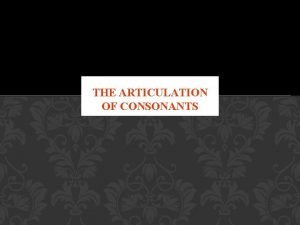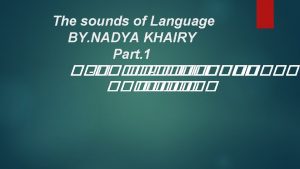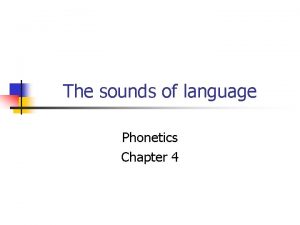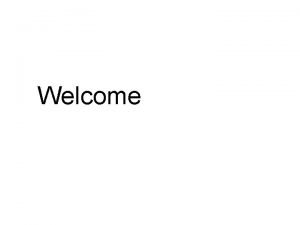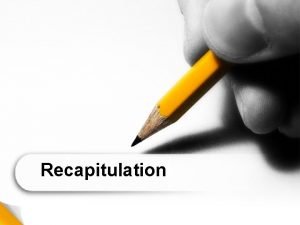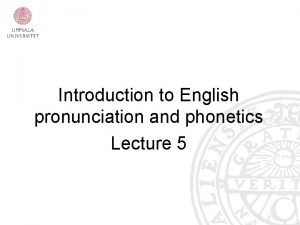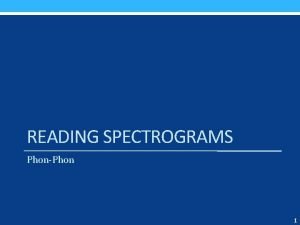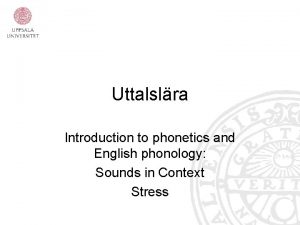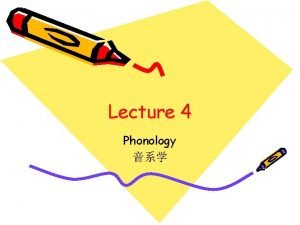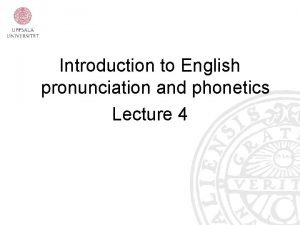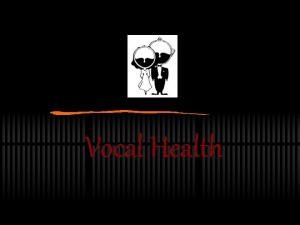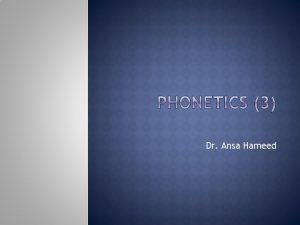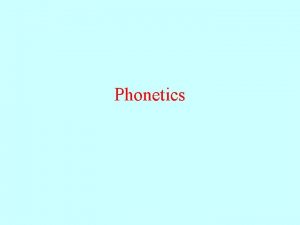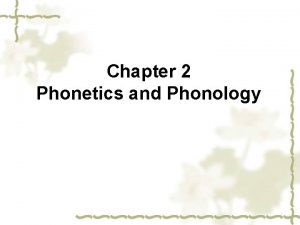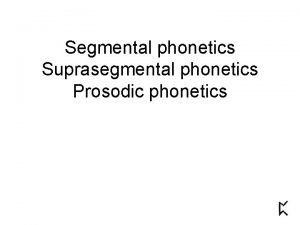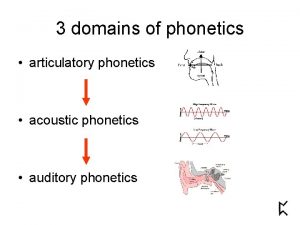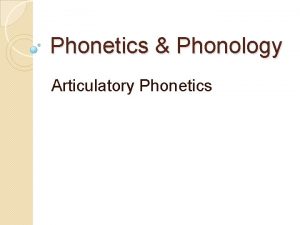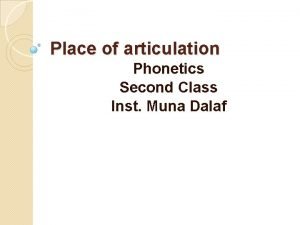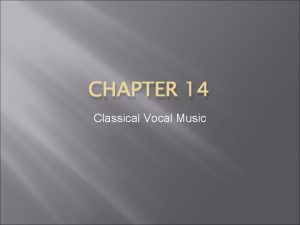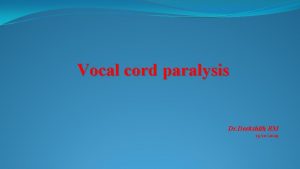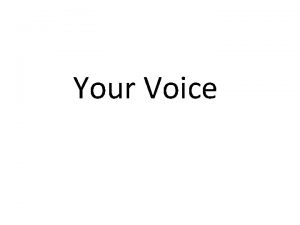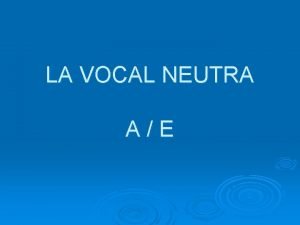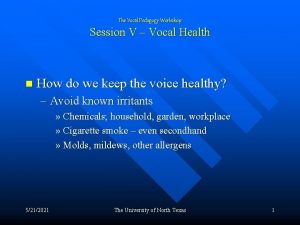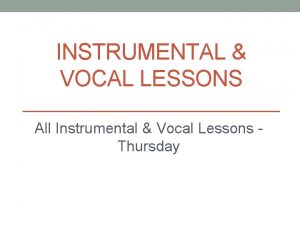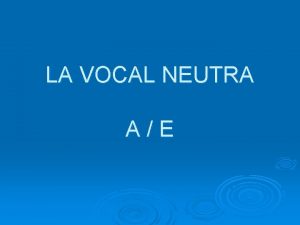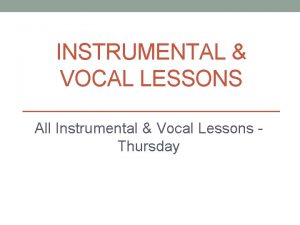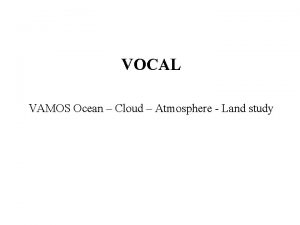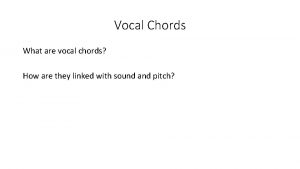Phonetics Place of Articulation CH 3 The Vocal






















- Slides: 22

Phonetics Place of Articulation CH. 3

The Vocal Tract • Air coming from the lungs passes through the vocal folds, and then through the pharynx (pharyngeal cavity). • After that, the airstream can enter and pass through one or both of the nasal and oral cavities. The oral cavity is bounded on the visible, outward side by the lips. • It is worth noting that the primary function of the speech organs is not speech production at all. Each contributes first and foremost to our survival. • The fact that we have also learnt to use them to communicate is ingenious and fascinating.

Active and passive articulators • Active articulators are the organs that can move, these are associated with the lower jaw. • Passive articulators are the stationary fixed organs, these are associated with the upper jaw.

The Tongue • The extreme flexibility of the tongue makes it the most important organ of speech. Certain parts of the tongue can move relatively independently of each other and it is best to regard each part as a separate active articulator. • Accordingly, we need to distinguish six different parts of the tongue. • The tip (apex) and the blade (behind the tip) are the unattached portion. Behind these, where the tongue starts to be anchored to the floor of mouth, is what we call the front. • The last visible part, underneath the velum at the back of the mouth, is actually called the back • The term centre can be used to describe a mid-way point between the front and the back. Invisible, and forming the front wall of the pharynx, is the most firmly anchored part of all, the tongue root.


Identifying The Primary Places Of Articulation • Mostly, places of articulation are passive points along the upper surface of the vocal tract which are approached (sometimes contacted) by the corresponding active articulator during the production of a sound. • When the speech organs are in the rest position, there is an inherent alignment between points on the upper and lower surfaces, and the ‘corresponding active articulator’ on the lower surface of the vocal tract that is in an inherent relationship with the point on the upper surface. • In the rest position, the velum and the glottis are both open – there is an unobstructed passage from the nostrils to the lungs, that’s how we can breathe when the mouth is closed. This is the rest position.

Place Names/ active, passive • If we consider the remaining parts of the tongue, we can see that the blade is directly below the alveolar ridge and the area immediately behind it, the post alveolar area; behind that, the front of the tongue is below the hard palate; the centre lines up approximately below the intersection where the palate changes from hard to soft; the back is below the soft palate, or velum, and adjacent to the uvula; the root is opposite the rear wall of the pharynx. These relationships are taken for granted when we start to delineate what we call place of articulation. • Basically, a place of articulation is any passive point that is approached or contacted by its relevant active organ. One place not included is the infrequently used, and therefore rather rare place, Another is the equally rare linguolabial or apico-labial gesture. • The tongue as a single mass does not move forwards and backwards in the mouth, but it moves as parts

Labial articulations • The passive places on the horizontal axis of the IPA pulmonic consonant matrix (the large grid at the top of the IPA chart) can be grouped by active articulator. The first two columns, bilabial and labiodental, rely on the active contribution made in particular by the lower lip. • This is the phonetic information that phonologists rely on to define the feature [LABIAL]. Bilabial means ‘both lips’, whereas labiodental means ‘lip-teeth’. • It is a very simple easily mastered gesture& one of the first recognizable sounds produced by infants in the process of speech acquisition. • In bilabial articulations, the lower lip approaches the upper lip, in labiodental articulations, the lower lip moves up to form a relationship with the upper front incisors. • These are both primary articulatory gestures and no participation by any other articulator is involved • Lips shape is also used to classify vowels. too, tea

Lingual articulations: Coronals • The tip and blade of the tongue together are referred to as the crown. The British tradition here, however, follows IPA terminology and refers always and only to the tip and the blade. • The notion of ‘crown’ allows phonologists to group together all the articulations made with the tip and/or blade of the tongue and to identify them by the single feature [CORONAL]. • The grouping of dental, alveolar and postalveolar in this way and the provision • (except fricatives) of only one symbol (or one pair of symbols) in each row is motivated by the fact that languages tend to select one (or maybe two) of these places rather than using and contrasting all of them. • Multiple symbols in most rows would then be superfluous, redundant.

• Most English accents use an alveolar t-sound (tongue tip on the alveolar ridge) in tea, otter, sit. No language contrasts a dental-t with an alveolar-t, thus the one symbol will suffice. • In Irish English, however, many speakers will use both varieties – in an expression such as thin tin, you will find the pronunciation of the first word begins with a dental-t and the second with an alveolar-t. • So, since the IPA chart only provides one symbol, to show this difference we need to apply a diacritic to change the basic place value of the symbol. • [t] can be thought of as the average value here, a voiceless alveolar sound (located to the left under the alveolar column heading). • To move this forward to the dental position, we add what is often called the dental diacritic (‘subscript bridge’) which looks like a tiny drawing of a tooth, below the basic t-symbol: [t]. • This can be done to any alveolar symbol to show that the primary constriction between the tongue tip or blade and the passive articulator is with the (back of the) upper front teeth rather than with the alveolar ridge itself. The Irish English pronunciation of thin tin, therefore, would look and sound something like [tin tin].

• It is also worth noting here that the basic alveolar symbols can be used to represent postalveolar articulations by applying a retracted diacritic which is, effectively, a minus sign placed beneath the symbol. So, [t] is a voiceless postalveolar sound. (This is actually what happens when we articulate the tsound in try – you may be able to feel this yourself if you say the expression try Thai, slowly and carefully and think about what you can feel at the very beginning of each word – concentrate on where the tip of your tongue touches the roof of your mouth. )

Dorsals • The main body of the tongue (where the muscle starts to be more fully attached to the lower jaw and begins to lose some of its flexibility) is divided by phoneticians into the front, centre and back. These are again grouped by phonologists and described as sharing the feature [DORSAL]. • Dorsal articulations are much less visible to the observer, occurring further back in the vocal tract, using the palate as the passive articulator and including palatal (the front of the tongue articulating with the hard palate), velar (the back of the tongue articulating with the soft palate or velum), and uvular (the back of the tongue again, but this time articulating with the uvula).

• The precise point at which a gesture is made may be retracted or advanced from the primary position indicated by the symbol. Within this group of sounds, that is particularly true of velar articulations. • To experience this, say the phrase car key slowly, and concentrate on where you can feel the tongue making contact at the back of the mouth; then compare car with cot. You certainly feel the contact a bit further forward along the palate for key than for car. We can thus describe the variant of [k] in key as being advanced by placing a small plus sign below the main symbol: [k]. • For many speakers, too, there is different feedback in terms of point of contact for car and cot– the contact in cot may be slightly more retracted, [k]. This gives us a range from what is often called pre-velar [k] through velar proper [k] to post -velar [k] (this last with the retracted diacritic beneath the main symbol). • More detailed distinctions of this kind are possible for most places of articulation.


Radicals • The term radical refers to the root of the tongue where very little movement can occur. The tongue is pretty firmly fixed at this point and such movement results from tensing and relaxing the muscles that essentially form the front wall of the pharyngeal cavity. • Such gestures are required to produce pharyngeal consonants that are quite rare sounds in the world’s languages, being most commonly found in languages such as Arabic, Somali and Tigre. They are also found in at least one Amerindian language, Nootka, several Northwest Caucasian languages, and in the Indo. European Kurdish. • A further place of articulation in the radical region is epiglottal. These sounds are less widespread than pharyngeal. Because of their rarity, no column is allocated in the main matrix and, instead, the representations are listed under the Other Symbols section of the IPA chart. • The next figure shows the place of articulation


Glottals • The glottis also functions as a place of articulation. Sounds produced in the larynx, at the glottis, are identified by phonologists by the feature [LARYNGEAL]. • Two well-known possible glottal speech sounds are the h-sound, [h], and the sound often called the glottal stop or the glottal catch that is so characteristic of popular London speech (represented orthographically by an apostrophe: wha’ a lo’ (what a lot) or wa’er (water), and transcribed [ʔ]. • Accent of this kind tends to be an h-dropping accent (speakers don’t pronounce the [h] at the beginning of words like here, house, who), but it makes wide use of the glottal stop, regularly replacing t-sounds at the ends of syllables with it (what [wɒʔ], fit [fiʔ], winter [winʔə], etc. ). • Replacing final t-sounds by [ʔ] is called t-glottalling.

Apical and laminal • Cell entries in the IPA chart do not show that coronal gestures can be made by either the tip or the blade of the tongue, described respectively as apical and laminal articulations. • In spite of being closely linked anatomically, the tip and the blade are able to articulate separately with any one of these three passive points. • This already makes for an increased range of articulatory variation that is not immediately visible from the chart itself: apico-dental and lamino-dental, apicoalveolar and lamino-alveolar, apico-postalveolar and lamino-postalveolar. • This added subtlety is useful when attempting to characterize between-speaker differences in the realization of the s-sound in British English accents. • The difference lies in which part of the tongue they use to articulate with the alveolar ridge. Some make this with an apico-alveolar gesture, while others use the blade of the tongue, making a so-called laminal [s] with a lamino-alveolar gesture, [s]. • The IPA makes it possible to be absolutely precise in transcription about which gesture is in question.

Dental and interdental • In the pronunciation of th-sound at the beginning of think, speakers of most British varieties tend to use the tongue tip against the back of the upper front teeth in a straightforward apico-dental. • American Midwesterners are recorded as having the tip protruding slightly between the teeth in an interdental gesture (Ladefoged (2001). • There is no specific way of symbolizing this difference which is not known to be used to make an actual contrast in any language. • It can be argued that since the interdental gesture uses the surface of the tongue blade against the upper front teeth rather than the absolute tip, there is therefore an apical vs laminal distinction here ([˽θ] vs [θ]), (small sqaure under the second one) rather like the variation noted for [s]-articulations at the alveolar ridge. • Midwestern American pronunciation is laminal compared with British accents which are apical.

Linguolabial • The linguolabial gesture is when the tip or even the blade of the tongue steps completely out of its inherent relationship with the upper front teeth and the alveolar ridge and protrudes sufficiently to contact the upper lip. • Each, separately, can articulate with the upper lip at the labial position. In Table 3. 1, Tangoa (one of just a handful of languages, all of which are spoken in Vanuatu) was mentioned as using the linguolabial place of articulation. • The IPA provides the subscript seagull diacritic to represent this extreme gesture, placing it beneath the basic alveolar symbol such that [t] represents a voiceless linguolabial sound in ( Table 3. 1 and Table 3. 2).

Retroflex • Retroflex sounds are more common than the other consonantal gestures. • That’s why, they are included explicitly in the pulmonic consonant matrix. • For sounds made in this column, the tip and blade of the tongue are curled up and back-over in such a way that they articulate with the hard palate. • A more transparent name for this is apico-palatal. However, place names do not make overt reference to the active articulator, only to the passive target. • By coining the very graphic name retroflex, the IPA is able to identify this group of sounds using a single term, just like all the other places along the horizontal axis of the chart. • The difference is that unlike all the other names (which identify specific locations), this one describes a type of gesture or movement being made by the tongue. • Retroflexion may involve the use of either the upper or lower surface of the tongue tip and/or blade. American /r/ is retroflex in nature.

 Nurse jackie
Nurse jackie True vocal folds and false vocal folds
True vocal folds and false vocal folds Place of articulation consonants
Place of articulation consonants Place of articulation
Place of articulation Consonants place of articulation
Consonants place of articulation Phonetics and phonology
Phonetics and phonology Affricate
Affricate The sounds of language
The sounds of language Noncontinuants
Noncontinuants Millions billions trillions chart
Millions billions trillions chart A repeating disturbance that transfers energy
A repeating disturbance that transfers energy Disturbance that transfers energy from place to place
Disturbance that transfers energy from place to place English phonetic alphabet
English phonetic alphabet Rowe concise introduction to linguistics download
Rowe concise introduction to linguistics download Phonetics alphabet
Phonetics alphabet Differences between phonetics and phonology
Differences between phonetics and phonology Rp =
Rp = Spectrogram reading practice
Spectrogram reading practice Elision examples phonetics
Elision examples phonetics Narrow transcription
Narrow transcription Regressive assimilation examples
Regressive assimilation examples Dental phonetics
Dental phonetics Articulators theatre definition
Articulators theatre definition


